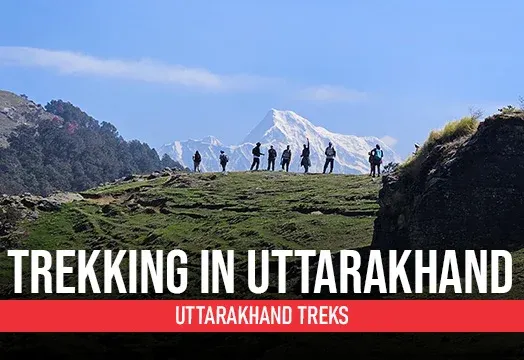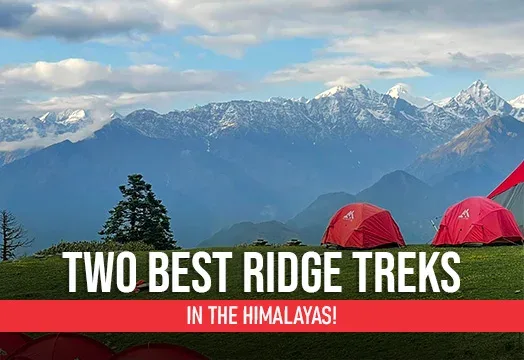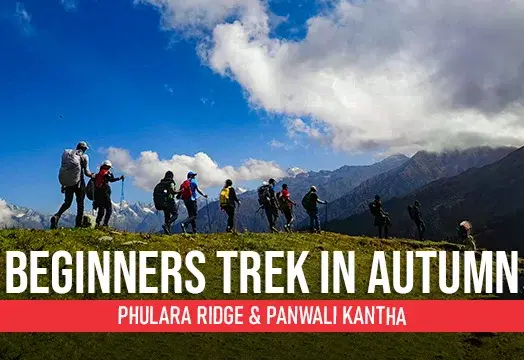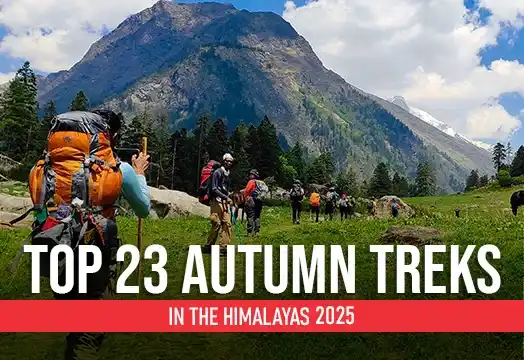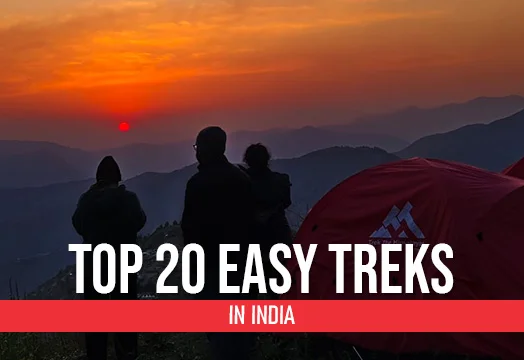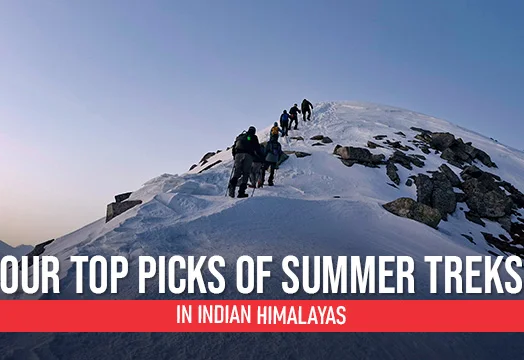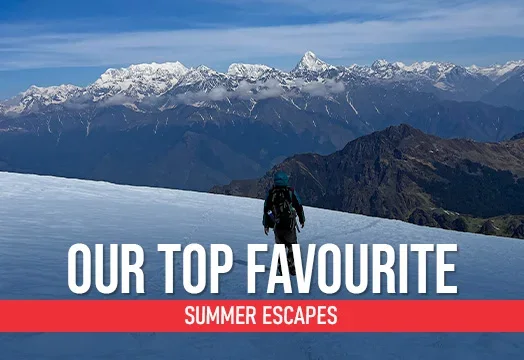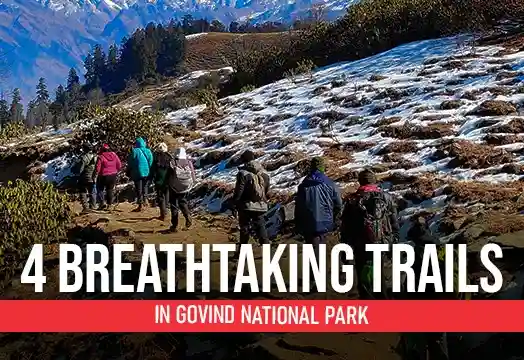Phulara Ridge Trek

Region
Uttarakhand | India

Duration
6 Days

Max Altitude
12150 Ft.

Trekking Km
29 KM

Grade
Easy to Moderate
Get in Touch with Our Trek Expert
91 7302321133 info@trekthehimalayas.comMonday - Saturday: 10 AM to 09.30 PM (GMT +5:30)
Sunday: 10 AM to 05.30 PM (GMT +5:30)
9500 /Person
- April-2026
- May-2026
- June-2026
- October-2026
- November-2026
- Services from Sankri to Sankri .
- Pickup & Drop Location:
Prince
Chowk
Pickup: 06:00 AM | Drop: 06:30 PM–07:30 PM (weather/road dependent)
Keep a buffer day and arrive a day early to avoid delays. - Base Camp Accommodation: Guest house stay with attached washroom (no bunk beds).
- Complimentary cloakroom at base camp for safe storage.
- Avail Special Casual Leave if you’re a Central Govt. employee.
Add-ons
Insurance 240
- Insurance is mandatory.
- It is available for Indian citizens only.
- Non-Indians have to take insurance on their own.
- If you already have the high altitude trekking insurance, email for a refund after booking.
- The cancellation policy will be implemented in accordance with the trek cancellation policy.
- For more details about insuranceclick here
- + 5% GST will be applicable
Transport 2200
- Transportation Dehradun to Sankri & return is optional.
- Choose add-ons during booking. If missed, log in and add them later.
- Book transportation at least 10 days before the trek.
- Cancellation 4 or more days before the start of the trip results in a 100% cash refund.
- Cancellation less than 4 days from the start of the trip results in a 50% cash refund.
- Cancellations made on the trip date are not eligible for a refund.
- + 5% GST will be applicable
Offload 1600
- Backpack offload is optional.
- Choose add-ons during booking. If missed, log in and add them later.
- Book off-load at least 10 days before the trek.
- For offline bookings at the base camp, a convenience fee of Rs. 2000 applies.
- Cancellations made before the trip date will receive a full refund.
- + 5% GST will be applicable
Single Occupancy Tent 1600
- Single Occupancy Tent is optional.
- Choose add-ons during booking. If missed, log in and add them later.
- Book Single Occupancy Tent at least 10 days before the trek.
- Cancellations made before the trip date will receive a full refund.
- + 5% GST will be applicable
Get in Touch with Our Trek Expert
91 7302321133info@trekthehimalayas.com
Monday - Saturday: 10 AM to 06 PM (GMT +5:30)
Overview
Trek Name: Phulara Ridge Trek
Days: 6
Adventure Type: Trekking
Base Camp: Sankri
Season:Summer | Autumn |
Month:May | June | October | November |
Country: India
Altitude: 12150 Ft.
Grade: Easy to Moderate
Rail Head: Dehradun
Stay: Guest house(Separate for male & Female)(attached washroom with running hot water), Camping in tents, twin sharing
Food: Meals while on trek & at guest house (Veg + Egg)
Location: Uttarakhand
Distance: 29 Km.
Trail Type: Circle trail | Camping in various locations, starting and ending at the same point.
AirPort: Jolly Grant Airport, which is 21 km away from Rishikesh
Highlights:
- Services from Sankri to Sankri .
- Pickup & Drop Location:
Prince
Chowk
Pickup: 06:00 AM | Drop: 06:30 PM–07:30 PM (weather/road dependent)
Keep a buffer day and arrive a day early to avoid delays. - Base Camp Accommodation: Guest house stay with attached washroom (no bunk beds).
- Complimentary cloakroom at base camp for safe storage.
- Avail Special Casual Leave if you’re a Central Govt. employee.
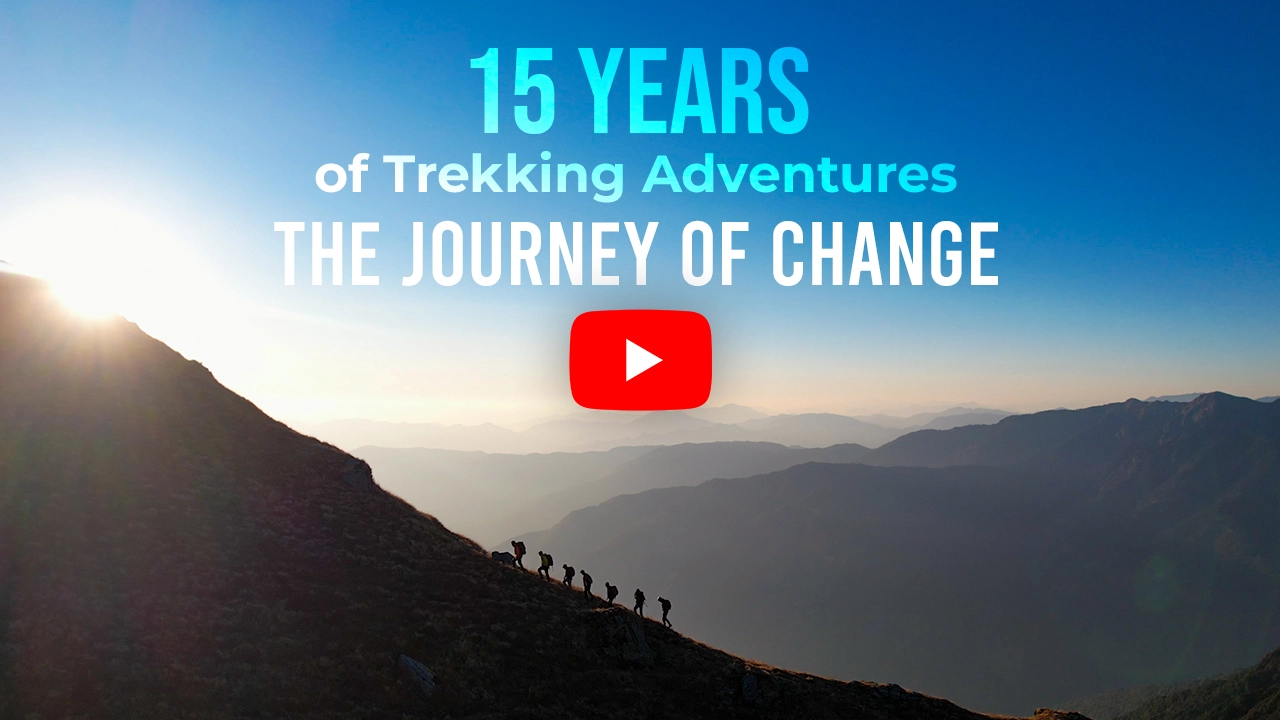
Phulara Ridge Trek - Unexplored Trail in Garhwal Himalayas
Govind Pashu Vihar National Park is home to multiple trekking routes. Sankri, situated within the park, acts as a base camp for treks such as Har Ki Dun, Bali Pass, and Kedarkantha. Pushtara Meadows via Phulara Ridge is one of the lesser-known but so far the best ridge trek in the country. The trek is very unique due to the landscape and the nature of its trail. Ridges are uncommon in the Indian Himalayas. But this trail takes you on a walk atop a ridge that lasts for almost 2 hours! Given that this is one of a kind trek in Uttarakhand Himalayas, it is slowly earning its well-deserved fame in the trekking world; it is best to visit it before the crowds arrive.
The Phulara Ridge Trek stretches for about 30 km After walking through this ridge for 4-5 hours, you see lovely meadows on one side and a captivating valley along with mountain views on another side, this counts for a mesmerizing experience. Phulara Ridge Trail is in the middle of two valleys where you find a trail to walk. It feels like you are walking through the edges of a knife.
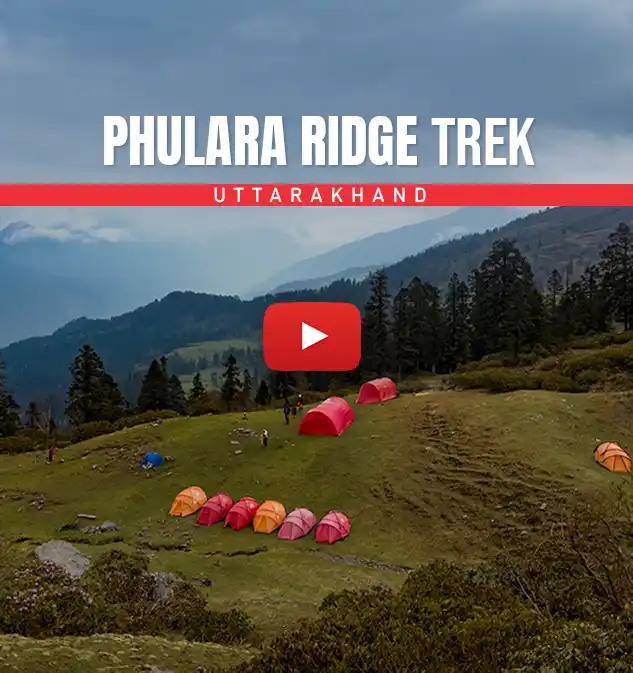
Who Can Participate
- Age Requirement:
- Minimum 9 years
- First-timers are welcome, though prior trekking experience is preferred. Good fitness is a must.
- Fitness Criteria:
- If the trekker wants to carry a backpack then he/she should be able to carry a 10-12 kg backpack. If opt Off-load option then the trekker should be able to carry a 3-5 kg backpack.
- If a trekker's BMI is more or less than the normal range (18-29), please consult our Trek Coordinator before booking.
Phulara Ridge Trek Itinerary
Dehradun - Sankri
- Altitude(Sankri): 1,950m/ 6,400 feet.
- Drive Distance: 200 km (9-10 hrs approx).
- Pickup: Dehradun at 6:30 AM.
- Transportation Amount is not included in the trek cost.
- Type Of Vehicle: Tata Sumo/Tempo traveler or similar vehicle.
- Network Available: BSNL.
- Arrival at Sankri: 5:00 PM.
- Stay in a hotel with, an attached washroom with running hot water.
Our journey starts from Dehradun where we will pick you up in Tata Sumo or similar vehicles at 6:30 AM. You are requested to report at the pickup point by the time. From Dehradun, we will drive to Sankri, which is at a distance of 200 km from Dehradun. It may take about 9 - 10 hrs or more to reach Sankri as the mountain roads can be quite bumpy at times. However, the road to Sankri is quite scenic.
On your way, you will cross picturesque places like Mussoorie, Mori, and Naitwar, etc. You will drive along the beautiful Yamuna and Tons River with pine trees lining the road. The River is milky white in some places and clear green in others. The fragrance of pinewood and the beauty of nature will make up for the long ride to Sankri. The last stretch of the road, about 22 km from Sankri, is even more beautiful as you enter the Govind National Park, famous for being home to much exotic flora and fauna. On reaching Sankri, we will check-in at our hotel. After freshening up, you can spend the evening at the quaint hamlet of Sankri at your leisure.
You can head out for a stroll through this charming village. Sankri is a trekkers’ hub as it is the base camp for not one or two but 11 Himalayan treks including popular treks like Har Ki Dun. At Sankri BSNL network is available but it is very erratic. You can also watch a beautiful sunset at Sankri Village in the backdrop of the Himalayas, a great opportunity for shutterbugs to capture all the beauty around. At night, you can have dinner at your hotel or in the local village dhabas to get a taste of the local flavors. Stay overnight at Sankri and we will start our trek the following day.
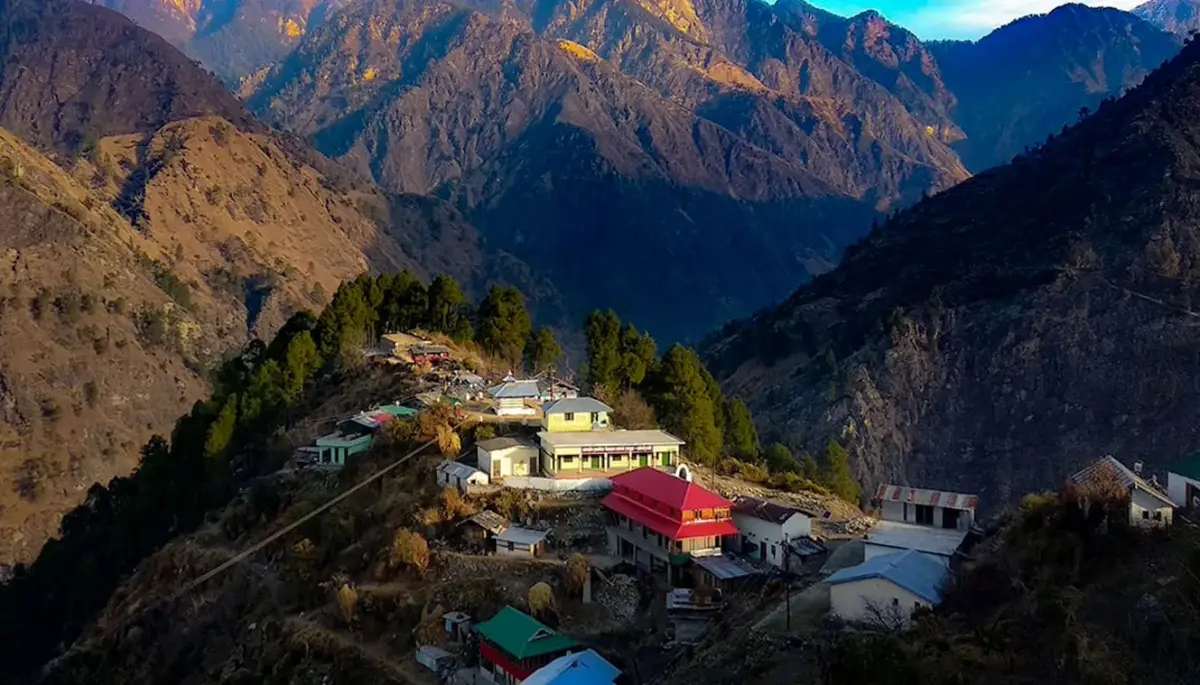
Sankri - Sikolta
- Altitude(Sikolta): 2850 m/9,400 ft.
- Trek Distance: 7 km | Duration: 5-6 hrs.
- Gradient: Moderate.
- Ascending trail.
- Water Source: Small stream near a broken bridge about 3.5 hrs into the trek
- Stay: In tents, Twin sharing.
On the first day of your trekking, today you will trek from Sankri to Sikolta basecamp. The first leg of the journey crosses through a serene pine cover and this is a great spot for bird watching. You may spot several varieties of Himalayan birds like treepies, drongos, barbets, woodpeckers, and more in the coniferous thickets.
The trail today is ascending throughout and as you continue climbing uphill, the forest will soon give way to a clearing where you will spot some dhabas. About an hour and a half on the trail, you will come across a bridge crossing which we will get to the other side of the river. Mind your steps as you climb uphill on the trail.
Walk on further and you will arrive at Jainot Thatch followed by an ascent to Marikoda, a scenic spot that unfolds the views of Dhunda Top on the left and the first glimpses of the Phulara Ridge. The trek branches here and one takes you to the beautiful alpine lake Juda Ka Talab while the other takes you to the Sikolta campsite. Walk onwards towards the Sikolta campsite and soon you will observe the majestic snow-covered peaks revealing themselves on the left and in the spring, the path is lined by Yellow Marsh Marigold and Lillies. Keep walking ahead until you reach a clearing in the meadow. This is your Sikolta campsite. You may spot some broken Gujjar huts here and towards your right, there is a water source that is filled with water during the post-monsoon season where you can refill your water bottles.
Once you reach Sikolta, set your bags down and pitch your tents. This is where you will camp for the night.
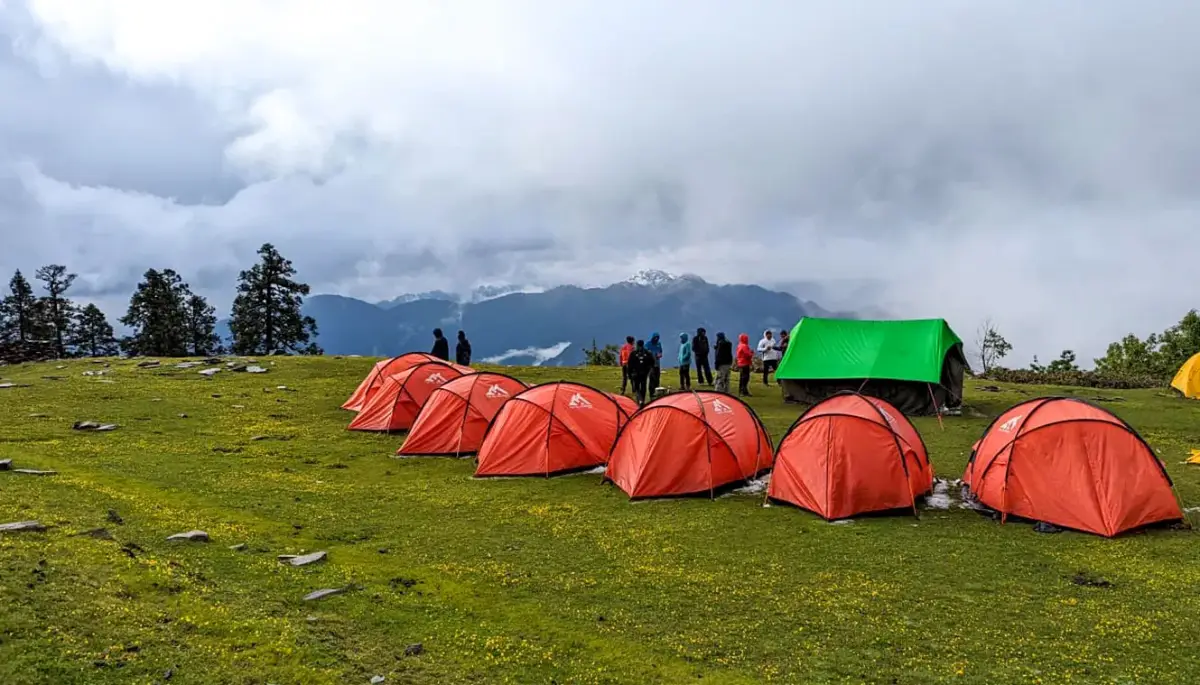
Sikolta - Bhoj Gadi
Today you will trek to the Bhojgadi campsite from Sikolta. The initial climb starts with walking through a dense forest for about 30 minutes. Crossing the forest, you will arrive at a water source, it is a lovely stream that flows under a bridge. You can fill up your water bottles here. Crossing the wooden bridge you will walk for about 15 minutes until you reach ‘Karasu Thatch’, which is a section in the trail filled with verdant green vegetation and lined by yellow wildflower blooms.
From Karasu Thatch, the Kedarkantha Peak is nicely visible. Take the moment to absorb the beauty of your surroundings. From here there are sections of both gradual ascents and descents and you will see the trail ahead dotted with Rhododendron and Bhoj trees. Thirty minutes of further walking opens the trail into lush meadows; Dhunda Top is clearly visible from here. To reach the Bhoj Gadi campsite, you will have to walk for about 15 more minutes. The campsite offers stunning views of Kedarkantha peak, & Swargarohini peaks. Set against the backdrop of green grasslands and the white canvas of snow-covered mountains, this is a great spot for shutterbugs to get their cameras out and capture the beauty of the landscape. Walk around the campsite or simply sit and relax and the serenity of nature engulf you slowly.
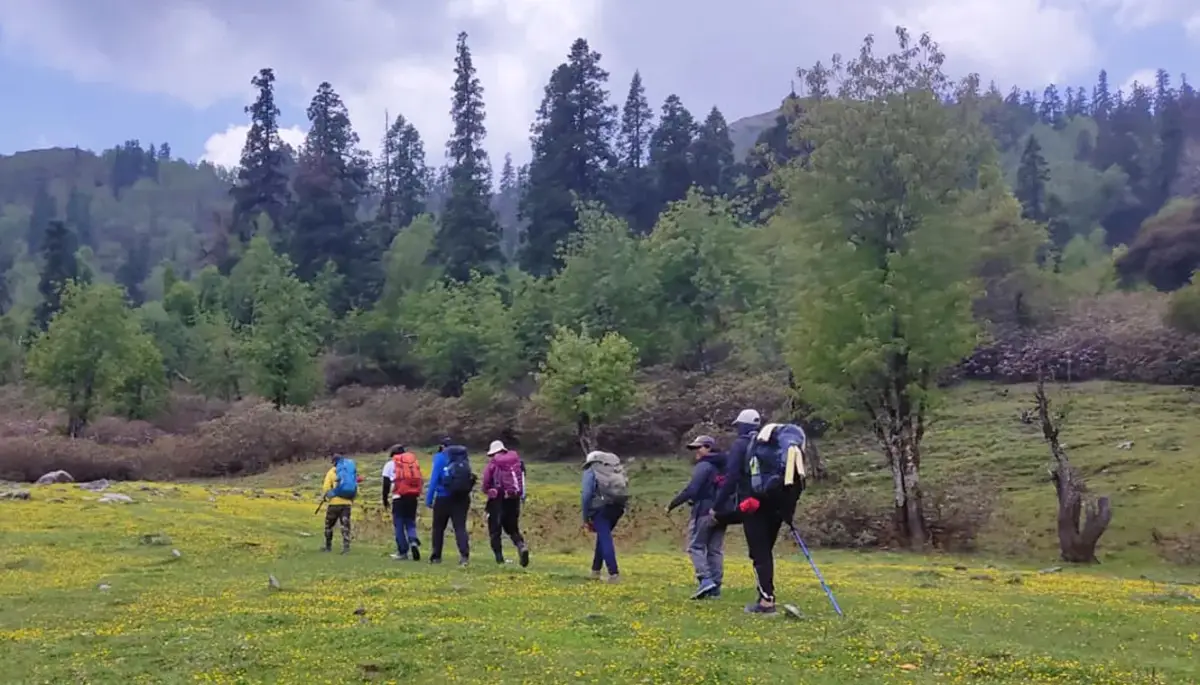
Bhojgadi - Pushtara via Phulara Ridge
Today’s trek will take you to Phulara Ridge and Pushtara campsite. Welcome the day with a mesmerizing sunrise view and you will head towards Pushtara meadows crossing the Phulara Ridge. Today’s trek is full of many ascents and descents and also the most scenic day of your trek.
Starting the trek early in the morning from the Bhoj Gadi campsite, we will reach the highlight point of our trek, the Phulara Ridge in about an hour. The Phulara Ridge is formed by a continuous chain of mountains that crest for some distance. From the ridge, you get unobstructed views of some of the most magnificent peaks of the Garhwal Himalayas like Bandarpoonch, Swargarohini, Kalanag, Kedarkantha, Ranglana, Hanuman Top, Sarutal, Hata Peak, and more.
The ridge drops to deep valleys on either side and as such, the mountain views from here are completely unobstructed. You will also catch a beautiful bird’s eye view of the Purola Valley in the distance. As the ridge ends, we will descend towards the vast, undulating meadows of Pushtara Bugyal. A picturesque expanse of green land, Pushtara Meadows offers a pleasant walk after the climb to the ridge. Marvel at the beauty of the meadows, dressed in green and dotted with various Himalayan wildflowers including the fabled Brahmakamal and fankamal. There’s a good probability to spot a rare Himalayan avian species here, the vibrantly colored Monal Pheasant, the state bird of Uttarakhand. The Pushtara Meadows will be our camping grounds for the night.
There are no water sources on the trail so it is recommended to carry at least 2 liters of water from the Bhoj Gadi campsite. You will have expert guidance from mountaineering-certified trek leaders all along the way and learn a lot of fun facts about the trek.
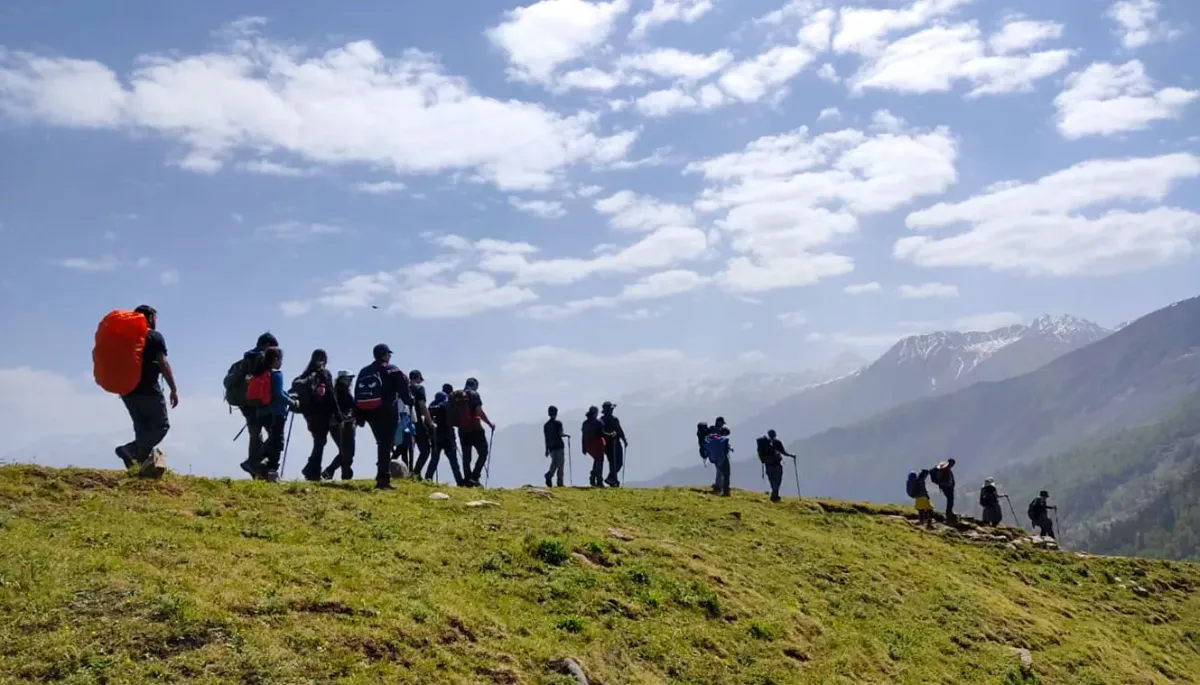
Pushtara - Taluka - Sankri
It is a complete descent to the village of Taluka and the last leg of your trek. Descend through the meadows of Pushtara for about 30 minutes and you will come across some broken Gujjar huts. Keep descending following the trail on your right and you will see a treeline start emerging which becomes denser. The valley floor is also strewn with beautiful yellow flowers.
Descending for another 30 minutes, you will enter into a forest. Stay on the trail as the forest is quite dense and wide so you may get lost if you wander away from the trail. Towering pine trees loom over you as you walk under their shadows. Be mindful of your steps as there may be a few trees fallen on the ground. You will need to manoeuvre around or over the trees to cross them.
Further descend for another 30 minutes and you will begin to see signs of civilization. Stay on your trail and you will come across a pathway and water collecting pipe. There’s a huge water tank and stone-roof wooden huts begin to appear on the right. This is the village of Tumrikot. A quaint Himalayan settlement. 30 minutes of walking and you will arrive at the end of your trek. You have arrived at the small village of Taluka. You will also see a clearly defined marking for the Har Ki Doon trek here. You will come to appreciate the simple domesticity of these remote Himalayan villages and their daily life. From Taluka, a vehicle will drive you to Sankri once again. You will stay the night in a hotel or homestay in Sankri.
At night you may venture out to the Sankri local market and buy some souvenirs as a token of remembrance of this memorable trip.
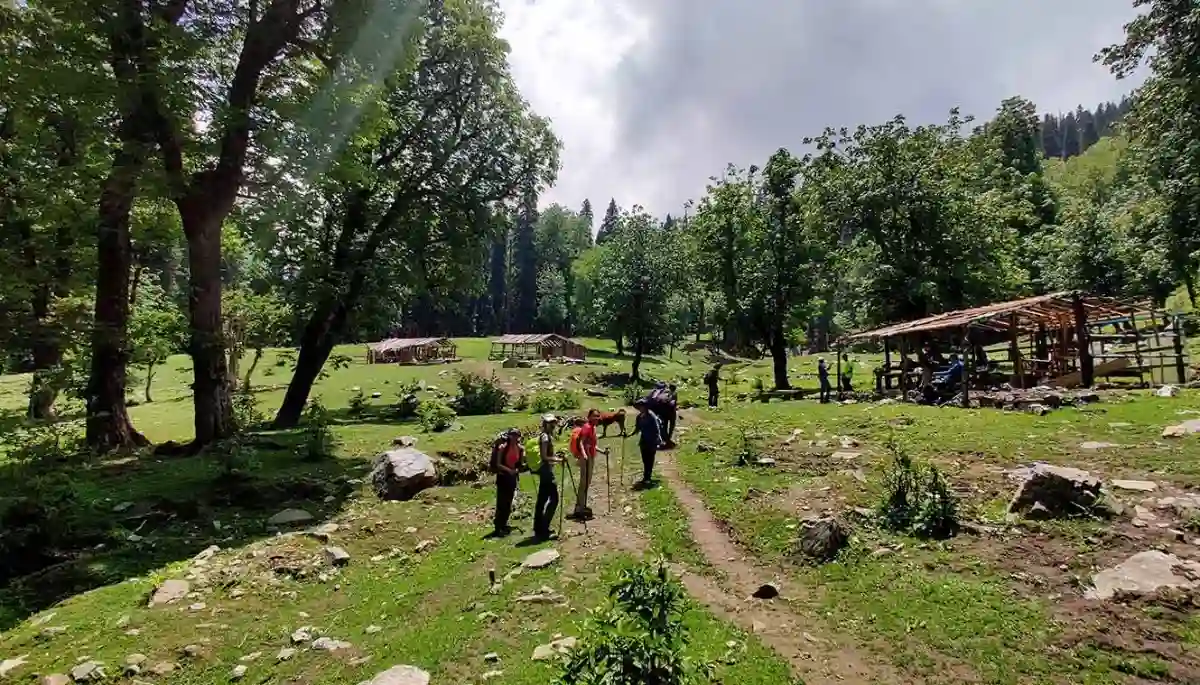
Sankri - Dehradun
We start the journey back to Dehradun today taking back with you the memories of an incredible experience in the mountains. Drive to Dehradun will take approximately 10 hrs and you will drive along the same scenic road that you came in. The timing may vary depending on the traffic and road conditions. We will drop you off at Prince Chowk, Dehradun and you can book your onward journey from here. If you wish to stay a few more days, you can explore Mussoorie or Rishikesh, popular tourist destinations in Uttarakhand.
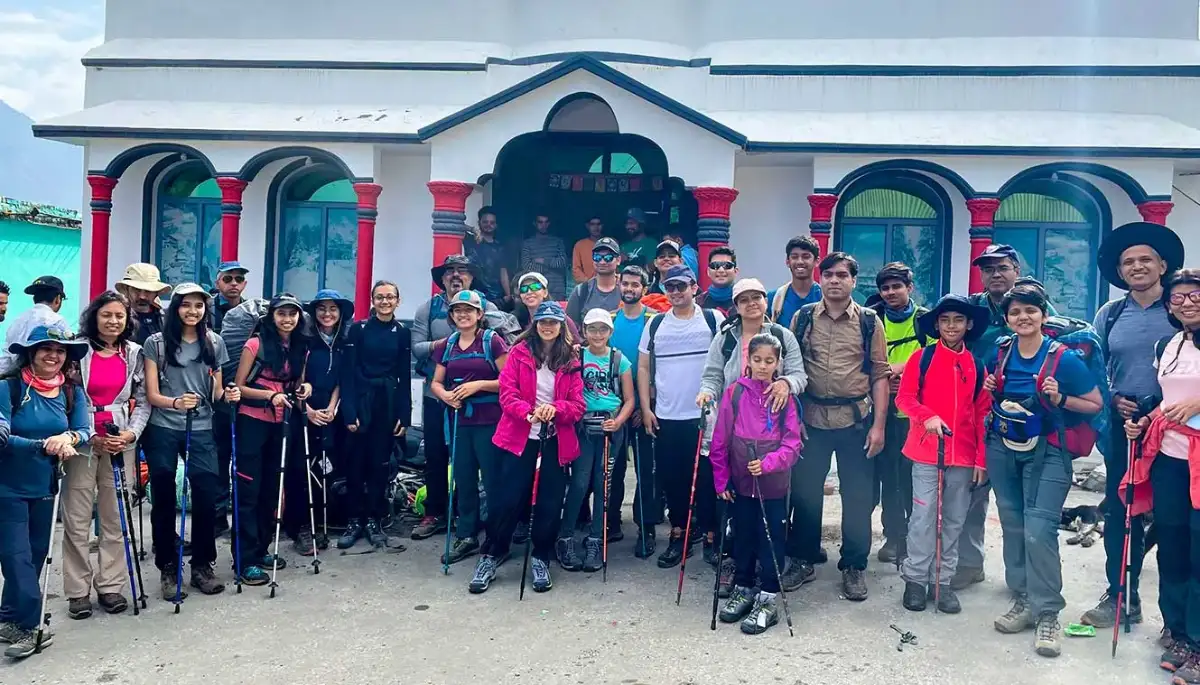
Day-1: Dehradun - Sankri
- Altitude(Sankri): 1,950m/ 6,400 feet.
- Drive Distance: 200 km (9-10 hrs approx).
Day-2: Sankri - Sikolta
- Altitude(Sikolta): 2850 m/9,400 ft.
- Trek Distance: 7 km | Duration: 5-6 hrs.
- Gradient: Moderate.
- Ascending trail.
- Water Source: Small stream near a broken bridge about 3.5 hrs into the trek
- Stay: In tents, Twin sharing.
Day-3: Sikolta - Bhoj Gadi
- Altitude: 11,100 ft
- Trek Distance: 4-5 km | Duration: 4-5 hrs
- Gradient: Easy to Moderate
- Ascending trail
- Water Source: A stream near a bridge an hour into the trek.
- Prominent Peak Views: Kedarkantha peak, Dhunda top, Lekha Top, Vijay Top, Swargarohini
- Stay: In tents, twin sharing
Day-4: Bhojgadi - Pushtara via Phulara Ridge
- Altitude: Pushtara - 9,500 ft, Phulara Ridge - 12,150 ft.
- Trek Distance: 8.4 km | Duration: 6-7 hrs approx.
- Uphill climb with a flat path on ridge followed by a descent to Pushtara.
- Water Source: No water source. Carry at least 2 liters of water from the Bhojgadi campsite.
- Prominent Peak Views: Bandarpoonch, Kalanag, Sarutal and Hanuman top, Ranglana, Devkyara, Swargarohini, and more.
- Stay in tents, twin sharing.
Day-5: Pushtara - Taluka - Sankri
- Altitude: 6900 ft (Taluka), 6,400 ft (Sankri).
- Trek Distance (Pushtara - Taluka): 8 km | Duration: 5-6 hrs approx.
- Gradient: Easy to moderate.
- Descending trail to Taluka.
- Water Source: A stream just before entering the forest, about 1.5 hrs into the trek.
- Drive Distance (Taluka - Sankri): 12 km | Duration: 1 hr approx.
- Landmarks on the way: Broken Gujjar huts, logging of timber, water tank, Tumrikot Village.
- Stay in a guesthouse , with an attached washroom with running hot water.
Day-6: Sankri - Dehradun
- Drive Distance: 200 km | Duration: 9-10 hrs approx.
- Transportation Amount is not included in the trek cost.
- Dropoff: Prince Chowk, Dehradun railway station 6:30 pm to 7:30 pm (Timings are subject to change based on weather and road conditions).
Note:
- Keep a buffer day in your travel plan.
- If buffer day is not used in the travel then it can be used to Explore Dehradun.
- Read the article Things to do in Dehradun.
- Distance, Altitude, and Trekking hours are approximate and rounded off.
- Keep the original and copy of ID proof handy.
- Come one day early if planning to come by plane.
Phulara Ridge Trek Graph
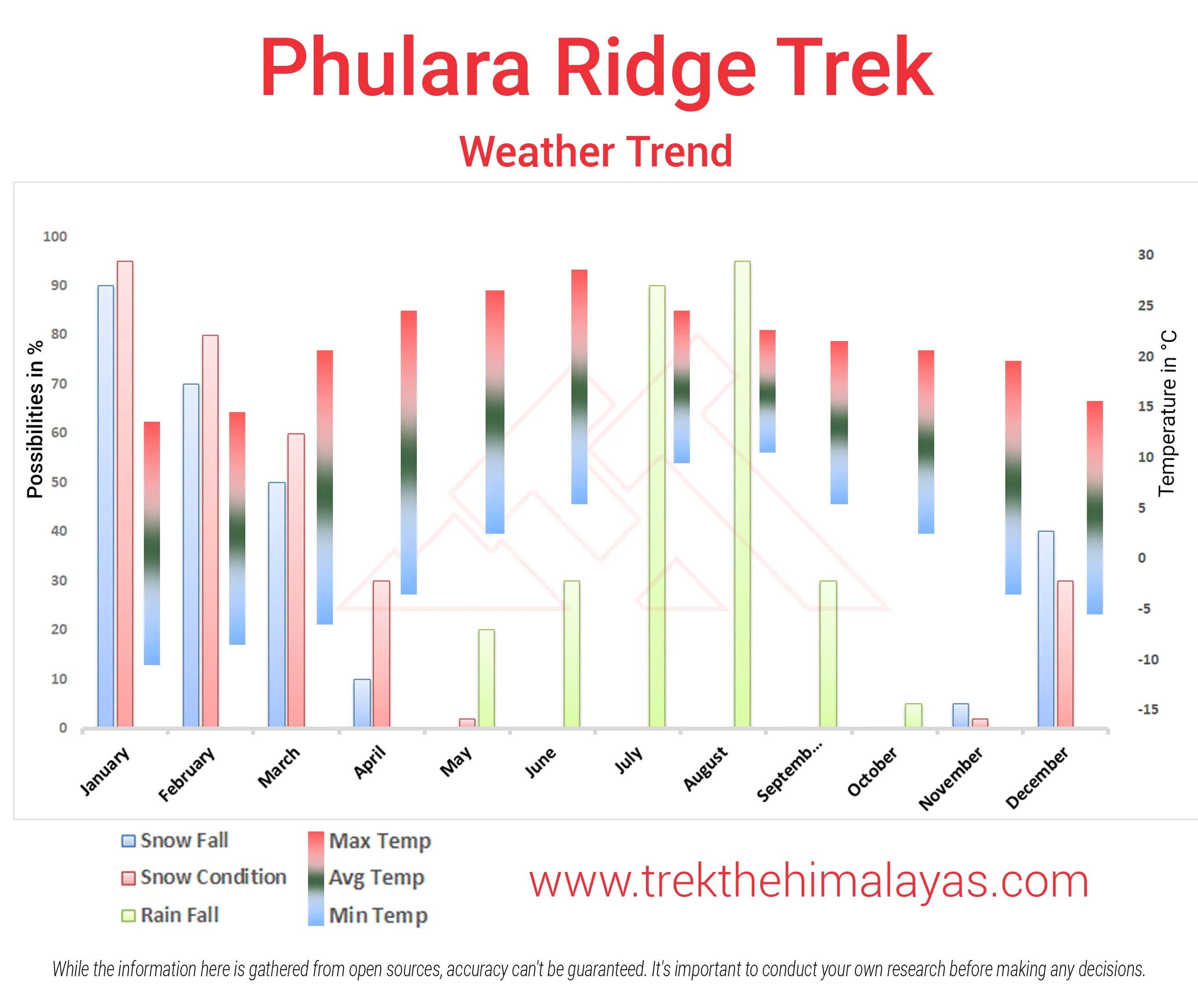
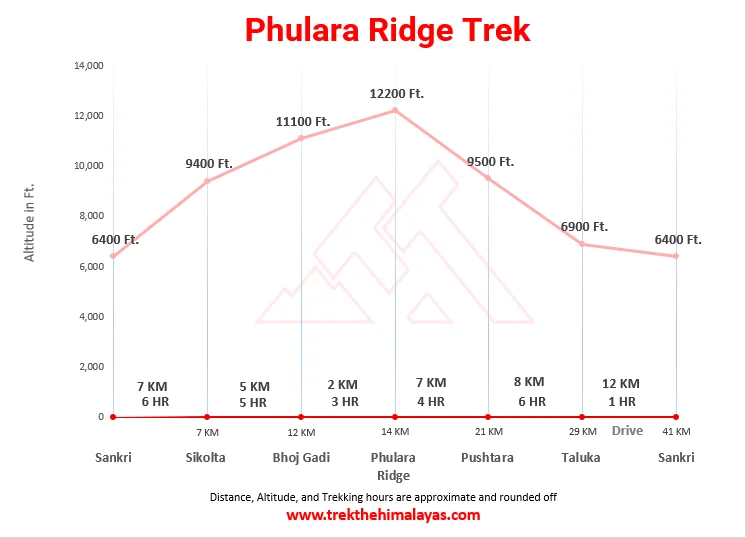
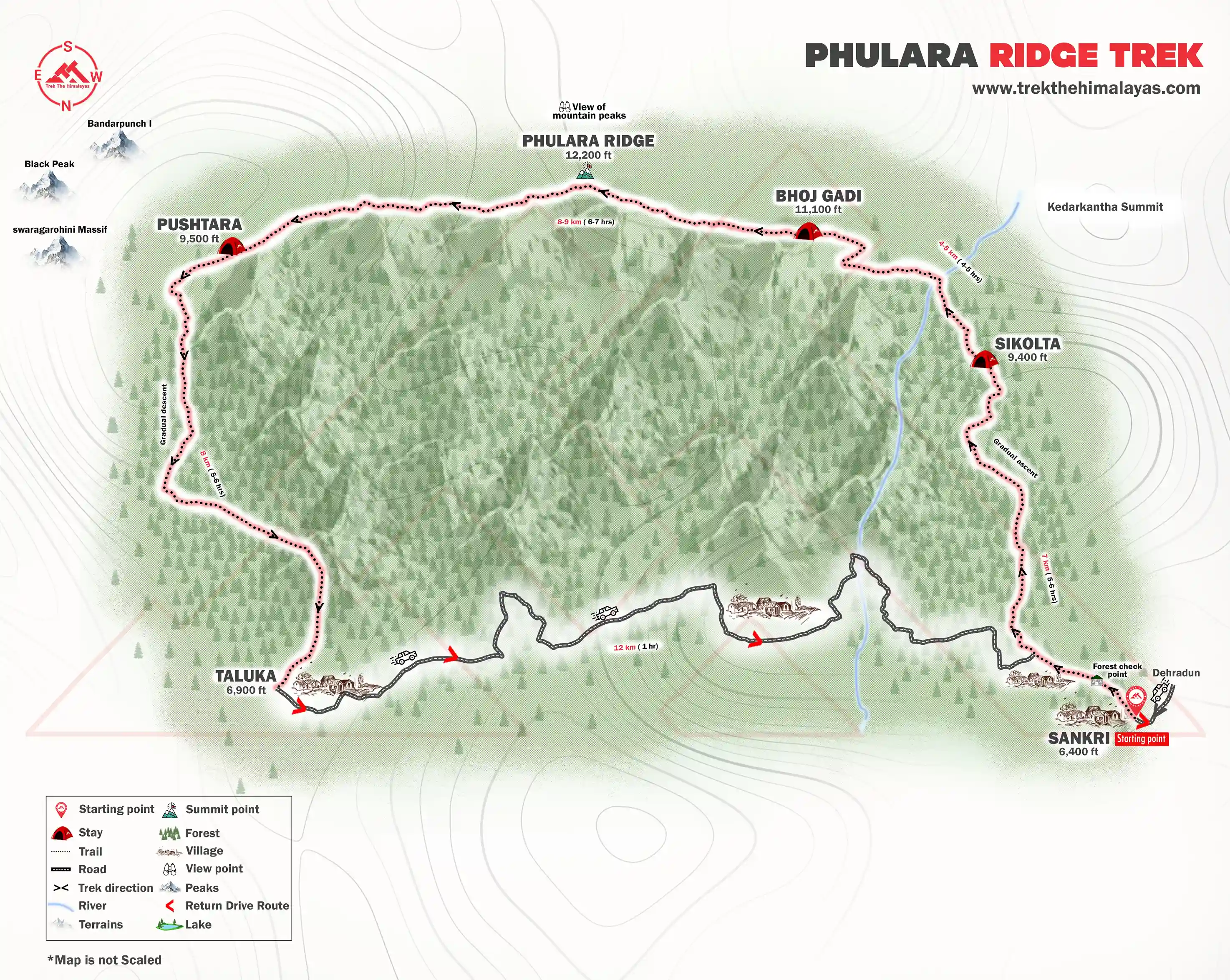
- Pulse rate at rest must be in between (60 to 100 beats per minute).
- Blood Pressure Reading must be in between (DIASTOLIC 75 – 85, SYSTOLIC 100 - 130 mm Hg).
- Respiratory rate at rest must be in between (12 to 20 breaths per minute).
- Should not have Liver and kidney issues.
- Should not have Diabetes Mellitus, Bronchial Asthma, Heart problems, Hypertension, etc.
- No pacemaker implant.
- People with Sinus issues, Epilepsy please contact to trek coordinator before booking the trek.
- If your BMI is not normal, Please contact our Trek coordinator before Trek booking.
Medical & Disclaimer Form (Mandatory Documents) Click here to download Medical & Disclaimer Form
Government employees can avail the benefit of Special Casual Leave (SCL) when they join us for a trekking expedition. As per Pay Commission guidelines, up to 30 days of Special Casual Leave can be availed in a calendar year for trekking or mountaineering expeditions conducted through a registered organisation.
Trek The Himalayas is a registered adventure tour operator with the Indian Mountaineering Foundation (IMF) and the Ministry of Tourism (MoT), making your trek eligible for SCL benefits.
To apply, email us at info@trekthehimalayas at least 20 days before the trek departure date, with the following details:
- Trek name and trek date
- Booking details
- Full name
- Designation
- Department and department address
This benefit is exclusive to Indian Government employees and is applicable only for treks within India.
- Junior trekkers (below 15 years) should have a company of parents/guardians.
- Trekkers between 15 to 18 years can come solo with the disclaimer form signed by parent/guardian.
- Medical & Disclaimer Form (Mandatory Documents) Click here to download Medical & Disclaimer Form
Important Links
- Mandatory Documents to Bring on A Trek Click Here.
- How to pay Add-ons, Submit Medical Forms, and Dietary Preferences Click Here to watch Video
How To Reach
Pick-Up Information
- It is essential for everyone to arrive at Prince Chowk, Dehradun (06:00 am).
- Once you have reached Dehradun, TTH will manage the rest of your travel arrangements, if you have opted for TTH's pick-up service, you can select this option during the booking process by adding it as an add-on.
Options to Reach Dehradun
First, you can arrive at Delhi, Dehradun Airport or Chandigarh. The journey from these locations to Dehradun is explained below.
1. Take an overnight train from Delhi to Dehradun.
2. Take a bus to Dehradun ISBT from Delhi Kashmiri gate ISBT or Chandigarh Sector 17 Bus stand, and then take local transport to the pickup point (Prince Chowk).
Delhi to Dehradun - 250km | 6hr.
Chandigarh to Dehradun - 220km | 5hr
The distance from the Dehradun Bus Stand (ISBT) to the Railway Station is 6 km, without traffic, it will take 15 minutes.
( We always recommend to go for the govt. Buses over the private ones outside the bus station as based on the experience we have found that there are very high chances of delay involved with private buses. Also, govt. Buses are always more reliable. Whichever bus you choose, just make sure to reach Dehradun at least by 05:30 am positively. )
3. Take a flight to Dehradun airport (Jolly Grant Airport), then from the Airport to Prince Chowk, Dehradun Distance is 30km and it will take around 1 hr( if coming by flight then reach one day early).
Drop-Off Information
- The designated drop-off point is Prince Chowk, Dehradun.
- Arrive in Prince Chowk by 6:30 to 7:30 pm.
- Please consider planning your subsequent travel arrangements after 9:00 pm.
- The distance from the Railway Station to Dehradun Bus Stand (ISBT) is 6 km, it will take approx 25 minutes.
- The distance from Railway Station to Dehradun Airport is 30km, it will take approx 1hr.
- It's highly advisable to keep a buffer day in your travel plan. If the buffer day is not needed, it can be used to explore Dehradun/Mussoorie/Rishikesh.
( If you prefer to travel independently to Base camp and don't want to take TTH's pick-up service, you can either take a government bus or book a private cab from Dehradun. Your trek coordinator will provide guidance on how to arrange for the bus or cab booking. )
TTH offers comfortable transportation through Tempo Traveler, Bolero, or equivalent vehicles. If you wish to upgrade your mode of transportation, please contact your trek coordinator for further assistance.
.webp)
Cost Terms
Inclusion
1. Insurance is Mandatory.
2. Accommodation (as per the itinerary):
- Guest houses – Triple/quad/penta sharing.
- Camping during the trek (Twin sharing basis).
3. Meals (Veg + Egg):
- Day 1 dinner to Day 5 dinner as per the itinerary, Drinking water while on trek (Tap/Mountain water).
4. Support:
- 1 Versatile base camp manager: handles communication and deploys extra manpower in emergencies.
- 1 Mountaineering & First aid qualified professional trek Leader.
- 1 Experienced high-altitude chef.
- Local experienced guides (Number of guides depending on the group size).
- Enough support staff.
5. Trek equipment:
- Sleeping bag, Sleeping liners (if required), mattresses, and Utensils.
- 3 men all season trekker tent (twin sharing), Kitchen & Dining tent, Toilet tent.
- Camping stool, Walkie talkie.
- Ropes, Helmet, Ice axe, Harness, Gaiters & crampons (if required).
6. First aid:
- Medical kit, Stretcher, Oxygen cylinder, Blood pressure monitor, Oximeter, Stethoscope.
7. Mules/porters to carry the central luggage.
8. Cloakroom facility available at the base camp for additional luggage
9. All necessary permits and entry fees, Upto the amount charged for Indian
10. Services from Sankri and Sankri.
11. Trek Completion Certificate.
Exclusion
- Insurance (For non-Indian Nationals, NRI or OCI card holders).
- Food during the transit.
- Any kind of personal expenses.
- Mule or porter to carry personal luggage.
- Emergency evacuation, hospitalization charge, etc.
- Any extra costs incurred due to extension/change of the itinerary due to natural calamities roadblocks, vehicle breakdown, etc. factors beyond our control
- Anything not specifically mentioned under the head Inclusion.
Things can be provided on demand and availability (participant has to pay extra for these things).
1- Satellite phone/set phone - a type of mobile phone that connects via radio links via satellites orbiting the Earth instead of terrestrial cell sites like cell phones. Therefore, they can operate in most geographic locations on the Earth's surface.
2- Gamow/PAC HAPO Bag (Portable Hyperbaric Bag) - is a unique, portable hyperbaric chamber for the treatment of acute mountain sickness (AMS), also known as altitude sickness.
3- AEDs (Automated External Defibrillators) - are portable life-saving devices designed to treat people experiencing sudden cardiac arrest, a medical condition in which the heart stops beating suddenly and unexpectedly.
Cancellation Terms
To request a cancellation, please email us at info@trekthehimalayas.com using your registered email ID.
Cancellations prior to 25 days from the start of the Trip
Refund Options
- 5% deduction of trek fee
- 100% trek fee cash voucher for any trip till one year
- Transfer your trek (any trek, any date) to your friend
Cancellation between 24 days and 15 days to the start of the Trip
Refund Options
- 30% deduction of trek fee
- 100% trek fee cash voucher for same trip till one year
- 85% trek fee cash voucher for any trip till one year
- Transfer your trek (same trek, any date) to your friend
Cancellation between 14 days and 10 days to the start of the Trip
Refund Options
- 50% deduction of trek fee
- 80% trek fee cash voucher for same trip till one year
- 70% trek fee cash voucher for any trip till one year
- Book the same trek, in the same season, with any other batch
- Transfer your trek (same trek, any date) to your friend
Cancellation less than 9 days to the start of the trek.
Refund Options
- No cash refund
- 20% trek fee cash voucher for the same trip till one year
- 10% trek fee cash voucher for any trip till one year
- Transfer your trek (same trek, same date) to your friend
- To reschedule a trek (same trek only), a 30 % rescheduling fee of the trek cost will apply.
Cancellation Policy (Emergency Cases):
In case of a death in the immediate family (parents, siblings, spouse, children) or if the trekker is hospitalized (min. 48 hours) or suffers a fracture (leg/arm) within a week before the trek, even if canceled a day before:
90% trek fee refund in cash & 10% as a voucher (valid for 1 year, for any India trek).
Valid documents required. We’re here to support you during tough times.
Note:
- Change of trek batch is dependent on the availability of seats in the batch
- In case of transferring a trek to a friend, he/she should satisfy all the mandatory requirements put forward by TTH
- TTH holds the right to change/cancel the policies, without prior notice
Booking and Payments
- The Participant is responsible for verifying the accuracy of all details, including Trip dates and personal documentation, at the time of booking.
- Payments must be made in accordance with the timelines and instructions provided by TTH. Late payments may result in cancellation of booking without refund.
- In the event of a cash refund, only the portion of the payment made in cash shall be eligible for refund in cash. Any booking made using voucher, discounts, promotional codes, or through any non-cash mode of payment shall not be eligible for a cash refund under any circumstances.
- Refunds, if applicable, shall be processed within 15–30 working days of confirmation.
- All add-on bookings are subject to the respective add-on cancellation policy, and refunds will be processed accordingly.
- Voucher Terms
- This is a non-transferable voucher
- The voucher cannot be merged with any other offer of Trek The Himalayas
- The voucher is valid for Trek booked directly with Trek The Himalayas in India
- To avail the voucher please use your register phone number or e-mail id
- All the other Terms of booking a trek with Trek The Himalayas are applicable to the voucher
Itinerary and Modifications
- TTH reserves the right to modify, shorten, or cancel any part of the Trip due to transportation delays, weather, health emergencies, or other unforeseen circumstances including Force Majeure.
Cancellations and Refunds
- No refunds or vouchers, partial or otherwise, shall be provided for voluntary withdrawal, non-utilisation of services, or removal from the Trip.
- If TTH cancels the Trip before arrival at the designated pick-up point due to unforeseen circumstances or Force Majeure, the Participant may choose from:
- An alternate Trip/date.
- A credit voucher valid for one (1) year.
- Transfer to another Trip, with cost differences payable by the Participant.
- If the Trip is abandoned post-arrival at the designated pick-up point, no cash refund or voucher shall be issued. The Trek Again Policy may apply at TTH’s discretion.
- TTH shall not be liable for any associated travel costs such as flights, accommodation, or visa fees.
Force Majeure
- Events beyond its control including but not limited to earthquakes, landslides, strikes, curfews, war, pandemic, government restrictions, heavy rainfall or snowfall, windstorms, road blockages, trail disruption, or withdrawal of permits, TTH shall not be held liable for any cancellation, delay, or service modification caused by Force Majeure.
Trek Essentials
Rent EquipmentPDF Of Trek Essential Download
| Backpack with rain cover | (50 - 60 ltr) with comfortable shoulder straps |
| Day pack with rain cover | 20 - 30 ltr (If off-load opted) |
| Walking stick | Advisable (At least one) |
| Water Bottle / Hydration pack | 2 thermos flask bottles of one liter each, Avoid hydration pack. |
| Small size tiffin/lunch box | 1 Nos |
| Snacks | Energy bars, dry fruits, electral/ors |
| Personal Medical Kit | Consult your doctor |
| T-Shirt (Synthetic quick dry) | 1 Full & 1 Half sleeves |
| Fleece T-shirt | 2 Nos |
| Wind stopper / Fleece jacket | 1 Nos |
| Windproof Jacket | 1 Nos |
| Down feather / Hollow jacket | 1 Nos. |
| Thermal inner (Upper and Lower) | 1 Pair |
| Trek Pant (Synthetic quick dry) | 1 Nos. |
| Wind stopper / Fleece Pant | 1 Nos |
| Waterproof gloves | 1 Pair |
| Fleece / woollen gloves | 1 Pair |
| Poncho / waterproof Jacket and pant | 1 Nos. |
| Sunscreen | 1 Nos. |
| Moisturiser | 1 Nos. |
| Chap-stick / Lip balm | 1 Nos. |
| Toothbrush and toothpaste | 1 Nos. |
| Toilet paper & Wipes | 1 Nos. |
| Hand sanitizers | 1 Nos. |
| Antibacterial powder | 1 Nos. |
| Quick dry towel | 1 Nos. |
| Head torch | 1 Nos. (Avoid Hand torch) |
| Sun Cap | Not required |
| Woolen cap | 1 Nos. |
| Balaclava | 1 Nos. |
| Buff / Neck-gaiters | 2 Woollen |
| Sunglasses | UV with dark side cover, People who wear spectacles - (A)- Use contact lenses | (B)- Photo chromatic glasses |
| Trekking shoes | 1 Pair (Water-resistant, high ankle, good grip) |
| Floaters / flip-flops | Not required |
| Cotton socks | 4 pairs |
| Woollen socks | 3 pairs |
| Gaiters | 1 Pair (TTH provides when required) |
| Micro spikes | 1 Pair (TTH provides when required) |
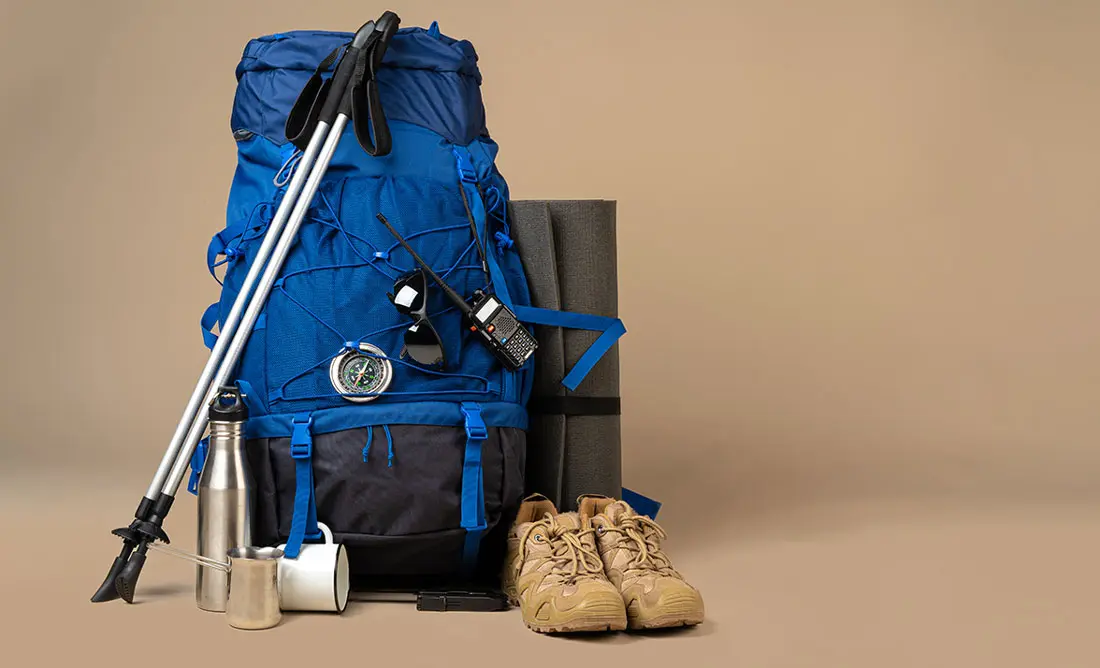
Frequently Asked Questions(FAQ)
To register with TTH, visit our website - www.trekthehimalayas.com and create your account. To create your account you will need to use your email address and fill in all the details, set your unique password and your account is ready to use.
- To book a trek with TTH, you first need to register with us and create an account.
- Choose the trek that you want to do and click on available dates.
- You will land at the login page, fill in the required details.
- Add Participants, choose add-on services click on the Pay now button, choose your preferred payment method, and make the payment. TTH accepts multiple payment options, including credit/debit cards, net banking, and UPI.
- You will receive a confirmation email from TTH with all the necessary details about the trek, including the meeting point, transportation, accommodation, and other important instructions.
- Click Here to watch Video
please send an email to us at info@trekthehimalayas.com or reach out to the numbers provided in the Help and Support section of your Trek Page. We will ensure that your issue is promptly resolved.
To book services such as off-load luggage and transportation, you can find them listed as add-ons. These additional services can be booked at the time of your initial booking. If you miss booking add-ons during the initial reservation, you can log in anytime and easily book 4 days before the departure date add-ons through the platform.
If you have booked the wrong trek or selected the wrong date, don’t worry! You can contact us at +91 9368882322 (Monday to Saturday, 10 AM to 10 PM) or email us at info@trekthehimalayas.com. You can also discuss this with your trek coordinator. Please make sure to inform us at least 10 days before the departure of your trek. Only then can we help you reschedule or arrange another trek for you.
We recommend visiting our "Suggest Me a Trek" page. By filling out the form, our experts will contact you with the best possible trek options based on your preferences and experience level. Alternatively, you can reach out to us via email at info@trekthehimalayas.com or give us a call using the numbers provided on our website for personalized assistance and recommendations.
Family treks differ from regular treks by focusing on ease of difficulty, offering shorter durations for younger participants, Kid-friendly and easily digestible foods, child-friendly activities, maintaining a higher guide ratio for diverse age groups, and implementing additional safety measures for families.
Family Trek with Kids recommendation Only Dayara Bugyal and Chopta Chandrashila Trek.
Minimum age for TTH treks is typically 7 years, though this may vary depending on the specific trek.
Yes, you can take a kids to a high-altitude trek with a parent. Discuss with a trek expert before booking a trek.
- Junior trekkers (below 15 years) should have a company of parents/guardians.
- Trekkers between 15 to 18 years can come solo with the disclaimer form signed by parent/guardian.
- Medical & Disclaimer Form (Mandatory Documents) Click here to download medical and disclaimer form
Physical Fitness: Ensure your child is physically fit. Engage them in regular exercise, outdoor activities, and hikes to build stamina and endurance. Hydration: Emphasize the importance of staying hydrated at high altitudes. Encourage your child to drink water regularly, even if they don't feel thirsty. Proper Nutrition: Provide a well-balanced diet with sufficient carbohydrates for energy and foods rich in iron to prevent altitude sickness. Adequate Sleep: Ensure your child gets enough sleep in the days leading up to the trek. Quality rest is crucial for altitude adaptation. Educate on Altitude Sickness: Teach your child about the symptoms of altitude sickness, such as headache, nausea, and dizziness. Encourage them to communicate any discomfort immediately. Appropriate Clothing and Gear: Dress your child in layers to adjust to changing temperatures. Ensure they have appropriate trekking gear, including sturdy footwear. Positive Mindset: Foster a positive mindset. Encourage your child, and let them know it's okay to take breaks when needed. Medical Check-Up: Schedule a medical check-up before the trek to ensure your child is fit for high-altitude activities. Consult with a healthcare professional about any potential health concerns.
TTH takes special care to provide wholesome and nutritious food for children on treks. Here are some of the foods that are typically served for children:
Breakfast: For breakfast, TTH serves a variety of options like porridge, cornflakes, bread, butter, jam, honey, boiled eggs, omelettes, and pancakes. Children can choose from these options to fuel themselves for the day's trek.
Lunch: For lunch, TTH serves lunch which includes rotis, vegetables, rice, dal, and salad. The rotis are usually made fresh on the trek and are a good source of carbohydrates. The dal and vegetables provide protein and other essential nutrients.
Snacks: TTH provides healthy snacks like fresh fruits, dry fruits, energy bars, cookies, and biscuits to keep the children energized throughout the day.
Dinner: For dinner, TTH serves a hot and wholesome meal which includes soup, rice, dal, vegetables, and a non-vegetarian dish (if requested in advance). Children can also choose from a variety of desserts like custard, jelly, and fruit salad.
Dietary requirements: If a child has any special dietary requirements, TTH can cater to those needs as well. For example, if a child is lactose intolerant or allergic to nuts, the kitchen staff can make arrangements to accommodate those requirements.
Choosing the right trek for a beginner can be a bit overwhelming as there are many factors to consider such as distance, elevation gain, terrain difficulty, weather, and time of year. Here are some tips that can help you choose the right trek for a beginner:
1. Determine fitness level: Assess the fitness level of the beginner to understand their physical capabilities. This will help you select a trek that is challenging but not too difficult.
2. Choose a well-traveled trail: A well-traveled trail will have more amenities such as signposts, water stations, and shelter. It is also safer as there will be other hikers on the trail.
3. Consider the length of the trek: For beginners, it is recommended to start with a shorter trek that can be completed in a day or two. This will help them get acclimatized to trekking and build their confidence.
4. Look for gradual elevation gain: Choose a trek with a gradual elevation gain rather than steep ascents. This will make the trek easier and more enjoyable.
5. Check the weather: Check the weather forecast before selecting a trek. Avoid treks during the monsoon season or winter when the trails can be slippery or dangerous.
6. Research the trail: Read about the trail to get an idea of the terrain, altitude, and difficulty level. This will help you select a trek that is suitable for the beginner.
7. Consult with an expert: If you are unsure about which trek to choose, consult our trek expert Mr. Nitin (+91 70600 59773) between 10 AM to 6 PM (Tuesday - Friday). Mr. Nitin will provide you valuable advice and guidance.
Overall, it is important to choose a trek that is enjoyable, challenging but not too difficult, and suitable for the beginner's fitness level and experience.
It is not recommended for a beginner to choose a difficult Himalayan trek. Trekking in the Himalayas can be physically and mentally challenging, especially if you are not used to the high altitude, steep slopes, and rugged terrain. Choosing a difficult trek without the proper experience, fitness level, and preparation can be dangerous and put you at risk of altitude sickness, injury, and other hazards.
If you are a beginner, it is recommended to start with an easier trek and gradually build up your skills and experience. This will help you understand the challenges of trekking in the Himalayas, and also prepare you physically and mentally for a more difficult trek in the future. It is also important to choose a trek that matches your fitness level, experience, and interest.
There is no specific age limit for a beginner trekker. However, it is important to consider your physical fitness, health condition, and personal interests before embarking on a trek. Trekking in the Himalayas can be physically and mentally demanding, and requires a certain level of physical fitness and endurance.
If you have any pre-existing medical conditions or are above a certain age, it is recommended to consult with a doctor before embarking on a trek. It is also important to listen to your body and take breaks as needed during the trek to prevent exhaustion or injury.
We recommend visiting our "Suggest Me a Trek" page. By filling out the form, our experts will contact you with the best possible trek options based on your preferences and experience level. Alternatively, you can reach out to us via email at info@trekthehimalayas.com or give us a call using the numbers provided on our website for personalized assistance and recommendations.
Yes, you can join the trek. We have fixed departure groups where you can simply book your trek and we will take care of curating a group.
Before you start the trek, it is recommended that you make all the necessary phone calls as during the trek you may or may not receive network coverage, once you come back to the Base Camp, you can reconnect with your family via phone once again. You can share your trek coordinator contact detail with your family members to get the latest updates about your trek batch.
At TTH, we provide wholesome and nutritious meals during the trek. The food is vegetarian and includes a variety of dishes such as rice, dal, vegetables, chapati, paratha, pasta, noodles, and soup. We also offer snacks such as biscuits, and salty, and dry fruits during the trek. Special dietary requirements such as vegan, gluten-free, or Jain food can also be arranged if informed in advance.
If you are allergic to some foods, you need to let us know in advance so that we can make arrangements accordingly.
TTH is a trekking company that prioritizes the safety of all its participants, including women trekkers. We have a comprehensive safety system in place, which includes a dedicated team of experienced and trained trek leaders and support staff who are equipped to handle emergency situations and provide first aid.
TTH also takes specific measures to ensure the safety and comfort of women trekkers. They have a separate tent accommodation for women trekkers, female trek leaders, and support staff. They also provide separate toilet facilities for women and encourage a safe and respectful environment for all trekkers.
Moreover, TTH has a strict policy against any kind of harassment and has a zero-tolerance policy towards such incidents. They have a designated Internal Complaints Committee (ICC) to investigate and address any complaints related to harassment or misconduct. Overall, TTH has a good reputation for safety and responsible trekking practices, and women can feel comfortable and safe while trekking with them.
In case you are the only women in the group, we provide a single sleeping arrangement. Also, during the trek, the trek leader will always remain by your side to provide optimum safety and reassurance.
You can reach out to the trek coordinator to inquire about the number of female trekkers and their respective states who have booked the trek. Please note that the trek coordinator cannot disclose personal details of any trekker. Once you've confirmed your booking, a WhatsApp Group will be created for all the trekkers in your batch. This allows you to connect with fellow trekkers before the trek begins.
While many of our treks are led by female trek leaders, however, it is not possible to know which trek leader is assigned to which group. But nonetheless, whether the trek leader is male or female you can be completely assured of your safety and security with us.
Yes, it is possible to trek with periods. However, it is important to take some extra precautions and preparations to ensure a comfortable and safe trekking experience. Here are some tips that can help you trek during your period:
1. Use menstrual hygiene products that you are comfortable with, such as tampons, pads, or menstrual cups. It is recommended to carry enough supplies for the entire duration of the trek.
2. Pack wet wipes, hand sanitizer, and plastic bags to dispose of used hygiene products.
3. Wear comfortable and breathable clothing that allows for easy movement and reduces friction. Avoid wearing tight or restrictive clothing that can cause discomfort.
4. Carry pain relief medication, such as ibuprofen or acetaminophen, in case of menstrual cramps.
5. Stay hydrated and maintain a balanced diet to support your energy levels and overall health.
6. Take breaks as needed and listen to your body. If you feel uncomfortable or experience any unusual symptoms, seek medical attention immediately. It is also recommended to consult with a doctor before going on a trek during your period, especially if you have a pre-existing medical condition or are taking medication.
By taking necessary precautions and being prepared, you can have a safe and comfortable trekking experience even during your period. We provide proper disposal facilities for sanitary pad disposal during the trek.
We offer three person tents with twin-sharing for optimum comfort. A woman trekker will share a tent with another woman trekker and if you are the only woman in the group, you will be given a single accommodation for your comfort and privacy.
Yes, we do provide gears on rent. You can book it using you TTH account directly.
Mountaineering qualified Experienced and first aid certified Trek Leader, First Aid Certify local guide, Cook, helpers and supporting staff.
People suffering from Bronchitis, Asthma, High blood pressure, Epilepsy (got faints), TB , Heart problem or on higher BMI side are strictly not allowed to go on any Himalayan trek. Apart from this if you had any medical history, please let us know.
No. Alcohol and smoking isn’t allowed while on trek. It is totally misconception that it will keep you warm. Your body need to acclimatize properly and for that eat properly and drink enough water; these things will keep you warm.
Toilet tents provide a convenient solution for answering nature's call in the great outdoors. Dry toilets, in particular, offer a highly sanitary approach. By digging a pit and utilizing mud and a shovel, you can easily cover up your waste. This method ensures cleanliness and hygiene while camping or exploring in the forest.
Remember to pack essential toiletries to complete your outdoor bathroom kit and maintain proper personal hygiene during your adventures. With these practices in place, you can enjoy nature while also respecting it.
Layer Up From Head To Toe
Eat Full Meals, never sleep empty stomach
You can keep warmee (if you’re more susceptible to cold).
Use sleeping bag in right way and don’t leave free space in sleeping bag.
For upper body
– Thermal layer
– T-shirt (full-sleeves)
– Fleece T-shirt (for extreme colds)
– Fleece layer
– Thick Jacket/Down Jacket
– Waterproof or Windproof layer (outermost layer, when it is snowing or raining)
- For Lower Body
– Thermal layer
– Hiking pants (normal) or Winter hiking pants
Based on how warm you feel you can skip any of the above layers. Your outer later should be windproof since it is windy at high altitude.
The idea behind layering is that the more insulation you have the less cold you feel, and instead of wearing a very thick jacket if you wear multiple layers, your body will be better insulated against the cold.
Yes, we provide micro spikes and gaiters, if required.
Mandatory documents: 2 xerox of ID having address (addhar card/driving license), 2 Passport size photographs, hard copy Medical form signed & sealed by doctor, disclaimer form sign by trekker and high altitude insurance.
No. We don’t but we can suggest you good hotel/Stay nearby pick up location.
Yes, trekker must carry 2 water bottles 1 litre each so they can refill it at campsite for drinking and keep themselves hydrate.
You should buy shoes which has these three features –Good grip, Ankle Support and additional water resistant layers. Generally, we advise Quechua Trek 100, MH 500 and MH 100.
No one is forced to go on. There is always enough staff to split the party according to need and regroup later at the camp. Most people have no trouble reaching the highest campsite. If some members decide not to climb the final distance they can wait for the climbers to come back down the same way or take a lateral path to the descent route.
The Phulara Ridge Trek is a beautiful and challenging trek that takes you through some of the most scenic landscapes in the Uttarakhand region of India. The trek begins in the quaint village of Sankri and takes you through dense forests of oak and rhododendron, alpine meadows, and gushing streams, offering stunning views of the snow-capped peaks of the Himalayas. The highlight of the trek is the Phulara Ridge, a narrow and steep trail that runs along the edge of the ridge, offering panoramic views of the surrounding peaks, including Swargarohini, Black Peak, and Bandarpoonch. The trek culminates with a visit to the beautiful Taluka village and the picturesque Osla village, known for its traditional architecture and local culture. The Phulara Ridge Trek is a perfect choice for those seeking a challenging and rewarding trekking experience in the lap of nature.
The best time to do the Phulara Ridge trek is in Spring (mid - Feb to mid - Apr), Summer (mid-Apr to June), and Autumn (Sep to mid-Nov).
Phulara Ridge Trek is a 6-days long trek.
The maximum altitude of Phulara Ridge Trek is 12,150 ft.
Trek The Himalayas follows this route Dehradun - Sankri - Sikolta - Bhoj Gadi - Pushtara - Taluka - Sankri - Dehradun.
During the Phulara Ridge Trek, you will stay in a guest house in the base camp, and on the slopes, you will be staying in tents (twin-sharing).
Yes, it is highly recommended to hire a professional expert for the Phulara Ridge Trek, especially if you are a beginner or have limited trekking experience. A professional can provide you with valuable assistance, including knowledge of the local terrain, weather conditions, and the culture of the region. They can also help you with navigation and ensure your safety throughout the trek.
Hiring a porter is optional, but it can be helpful if you do not want to carry a heavy backpack during the trek. A porter can carry your luggage and equipment, allowing you to trek more comfortably and at your own pace.
There are several nearby attractions to the Phulara Ridge Trek that you can visit like Mussoorie about 200 km from Sankri, Kempty Falls, Dhanaulti, Surkanda Devi Temple and popular treks like Kedarkantha, Har Ki Dun and more.
.webp)
.webp)
.webp)
.webp)
.webp)
.webp)
.webp)
.webp)
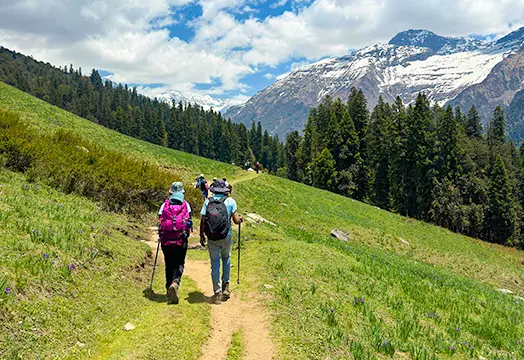

.webp)
